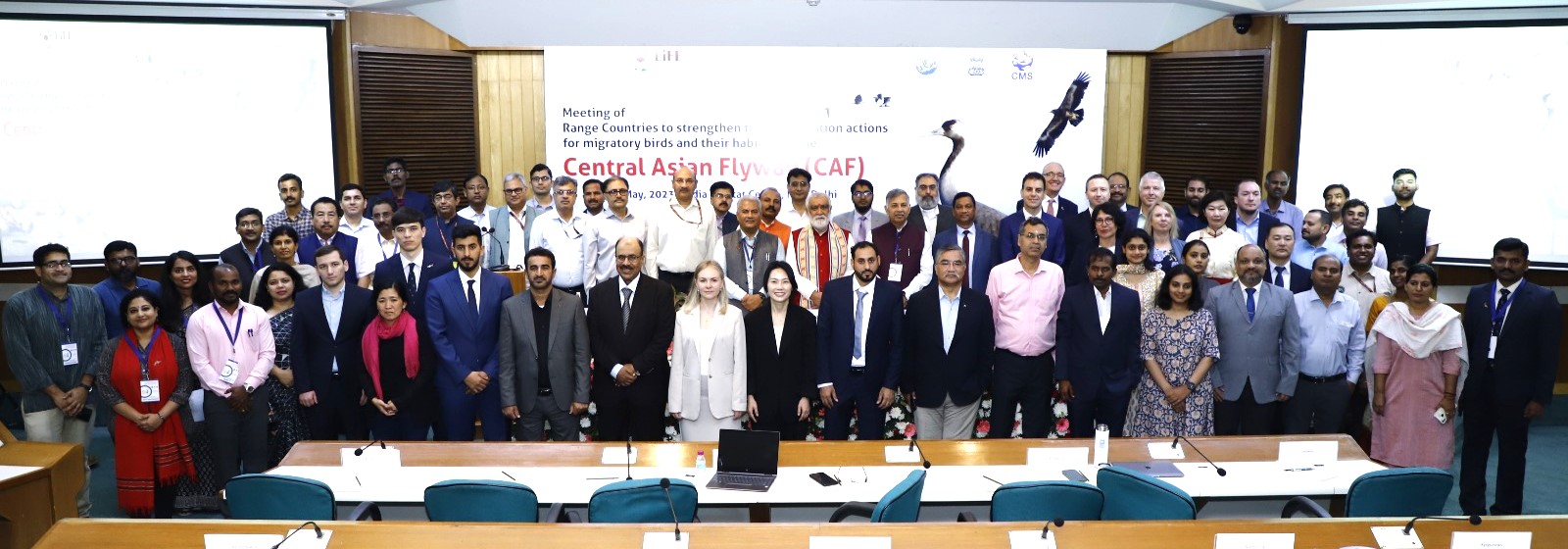
Range States Meeting on an Institutional Framework and next steps for the Central Asian Flyway
-
Capacity development
-
Species
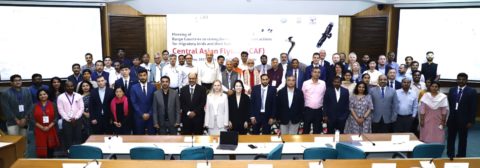
New Delhi hosted a successful meeting of the Central Asian Flyway (CAF) Range States that was organised by the CMS Secretariat and hosted by the Ministry of Environment Forest and Climate Change (MoEFCC), Government of India in New Delhi, between 2-4, May 2023.
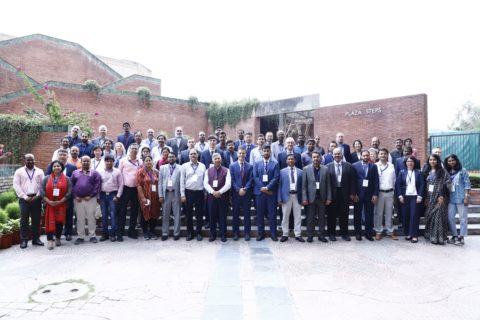
The CAF covers 30 countries, including the breeding grounds of many birds in Central and Eastern Russia, Central Asia, West, Central and Northern China and Mongolia. The CAF lies between the East Asian – Australasian Flyway and African Eurasian flyways. It overlaps with both particularly in the northern and central latitudes where many of the birds breed and stage on migration.
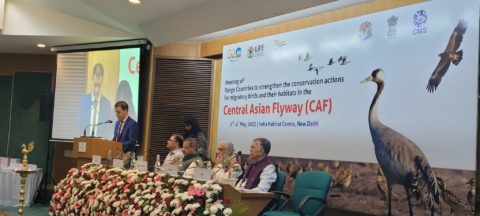
The meeting was attended by over 75 representatives of CAF range state governments (Armenia, Bangladesh, Kazakhstan, Kuwait, Kyrgyzstan, Mongolia, Oman, Saudi Arabia, Tajikistan, Uzbekistan and India), together with representatives of the Secretariats of CMS, the Memorandum of Understanding on the Conservation of Migratory Birds of Prey in Africa and Eurasia (Raptors MOU), the African-Eurasian Migratory Landbirds Action Plan (AEMLAP) and the East Asian – Australasian Flyway Partnership (EAAFP), and international organisations such as BirdLife International, Hanns Seidel Foundation, IUCN, WWF – India and Wetlands International, national NGOs including Bombay Natural History Society, senior representatives of the State Forest Department, Wildlife Institute of India, and others.
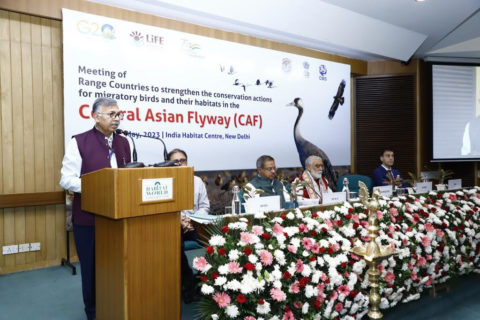
Mr Bivash Ranjan, Additional Director General of Forests of the Indian Ministry of Environment, Forests and Climate Change expertly chaired the meeting and successfully ensured a positive conclusion and outcomes. A range of interesting presentations were made by country representatives outlining challenges, ongoing research and management activities and opportunities for research and conservation action for a range of migratory birds and their habitats.
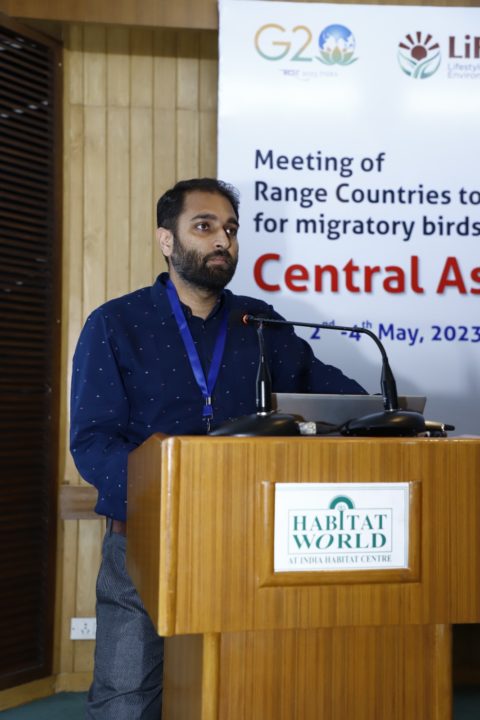
Mr Dhruv Verma, Senior Technical Officer from the Wetlands International – South Asia office presented Wetlands International’s flyway work to support monitoring and management of migratory birds and their habitats, including the annual International Waterbird Census, the Waterbird Populations Portal, Critical Site Network Tool and training kits to support capacity building.
Dr Taej Mundkur presented a draft Central Asian Flyway Situation Analysis report for migratory birds and their habitats developed by BirdLife International over the last months through an extensive consultation process and literature review. The report highlights the degradation and loss of all habitats and direct threats to birds including increasing collision and electrocution from power lines and other linear infrastructure, illegal killing, and poisoning across the flyway. The report provides a range of recommendations that aims to inform prioritization of international cooperation and conservation action.
Dr Mundkur, also as the Vice-Chair of Technical Sub Committee of the East Asian – Australasian Flyway (EAAF) Partnership introduced the informal multi-stakeholder partnership that has been actively promoting conservation of migratory waterbirds, including through management of an international network of flyway sites in the EAAF. He also shared information on a new multibillion dollar initiative led by the Asian Development Bank, EAAFP and BirdLife International with technical input from Wetlands International and others being developed to manage and restore a suite of internationally important sites across the flyway for migratory birds and people.
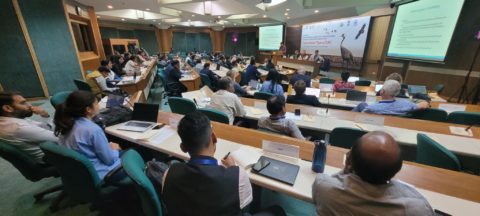
The meeting discussed ways to promote international cooperation between range states to conserve and reverse the decline of over 600 species of migratory bird of over families, including waterbirds, birds of prey, bustards, other land birds and seabirds that migrate and depend on a variety of habitats within the CAF.
There was a broad recognition of ongoing and past work across the CAF countries on species and habitats including research, monitoring, conservation, and restoration, capacity building and awareness-raising activities, involving citizen science, researchers, conservationists, NGOs, local grass-roots organisations and the corporate sector, in addition to by national and local government agencies and inter-government frameworks.
This landmark meeting built on the history of previous meetings of the CAF range states (in Uzbekistan, 2001, India 2005, UAE 2012 and India 2019) and follows on the decisions of the 13th meeting of the Conference of the Parties to CMS, held in Gandhinagar, India, in 2020.
The main outcomes of the meeting were to:
- Agree on an institutional framework for the CAF for all migratory birds through the establishment of a CAF Initiative, under the umbrella of the CMS and with the support of the Government of India, that will include governments, MEAs, international organisations, international NGOs and other stakeholders.
- Consider options for a CMS CAF coordination unit to be hosted by India in coordination with the CMS Secretariat.
- Draw conclusions from the draft comprehensive CAF Situation Analysis report presented by BirdLife International and discuss priority areas for implementation. The meeting agreed to contribute to finalization of the report by providing feedback by the end May to meet the aim of making the final report available at the CMS COP14 in Uzbekistan in October 2023.
- Develop and agree on a draft roadmap for updating the CMS CAF Programme of Work and Action Plan.
- Develop and agree on a draft CMS Resolution text, and the Terms of Reference for the new Initiative, as well as CMS Decisions outlining the next steps in the development of the initiative. These documents would be proposed for consideration and adoption to the CMS COP14 in Samarkand, Uzbekistan (Oct 2023).
The new CAF initiative will recognise and support/strengthen implementation of existing international frameworks (incl. AEWA, Raptors MOU, AEMLAP, CAF Waterbird Action Plan and EAAFP) in the CAF region. The developments would also contribute to efforts of the range states government to meet commitments under the newly agreed Global Biodiversity Framework, particularly the targets of effective conservation and management of at least 30% of the earth’s lands, inland waters, coastal areas and oceans, with emphasis on areas of particular importance for biodiversity and ecosystem functioning and services through the establishment of protected areas and other area-based conservation measures (OECMs), recognizing indigenous and traditional territories and practices, as well as restoration on at least 30% of degraded terrestrial, inland waters, and coastal and marine ecosystems. The initiative will also undertake a range of actions, funding permitted, as per a Programme of Work and Action Plan to be developed in the coming year/s to conserve migratory birds and their habitats.
Participants welcomed the lead of the Government of India in organisation of the meeting and in the promoting development of the CAF initiative and have offered their support and participation to make it a success. It was recognised that representatives of not all CAF range states attended this meeting and there would need to be active consultation with all range states and other stakeholders to invite and involve them in this new initiative.
The meeting called for a first meeting of the CAF initiative to be organised in 2024 to progress establishment of the coordination mechanism and confirm modalities for operations of the initiative and priority collaborative actions.
The draft resolutions, presentations and other meeting outputs are available on the CMS website https://www.cms.int/en/meeting/meeting-range-states-central-asian-flyway.
It is hoped that this important meeting will pave the way for the development of a new era of international cooperation between governments and other stakeholders in the Central Asian Flyway to promote the conservation of migratory birds and their habitats.
Contact
Mr Dhruv Verma, Wetlands International – South Asia
Dr Taej Mundkur, Senior Advisor, Wetlands International and Good Earth Environmental, the Netherlands
